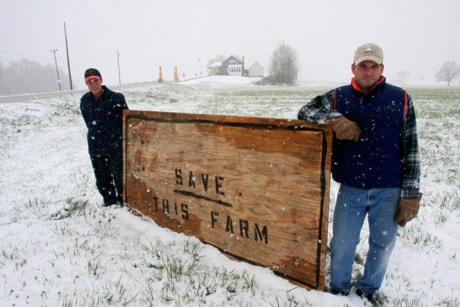FRANKLIN, Vt. — This is one sleepy border crossing.
At the Morses Line Port of Entry, on the U.S.-Canada border, the border station is located smack-dab in the middle of a Vermont dairy farm.
On average, 2 1/2 cars pass through an hour. The pace is so slow that U.S. Customs and Border Protection agents who man it have been known to fill out their days by driving golf balls in an adjoining meadow, shooting skeet or washing their cars.
Some here think the World War II-era brick structure that houses the border station should be abandoned entirely.
Not the U.S. Department of Homeland Security: The government, which got $420 million from the federal bailout to modernize land ports like this, wants to spend about $7 million to build an expanded station. To do it, the government says, it needs an adjoining 4.9-acre parcel now used to grow hay and corn.
Owners of the Rainville dairy farm were told last week that if they won’t sell the hayfield for $39,500, the U.S. Army Corps of Engineers will use eminent domain to seize it.
“The arrogance of it is breathtaking,” said Brian Rainville, 37, whose parents and two brothers run the 220-acre farm and milk 80 cows on it. “Why are we being asked to make that kind of sacrifice when they can’t demonstrate a public need?”
The public need is national security, according to Customs and Border Protection.
The building, which went up in 1936 after the government seized about a half-acre of land from the farm’s then-owner, is outdated by any standards. Its detention area is a bench with a set of handcuffs attached to one end, just inside the glass front door.
Trucks passing through have to be inspected as they sit on Morses Line Road, because the porte-cochere that hangs over the one inspection lane isn’t big enough to accommodate them.
Originally, a $15 million expansion was planned, using 10 acres of the Rainville farm. That plan has since been scaled back. It calls for a two-story building on 1.5 acres, with the rest of the parcel devoted to parking, vehicle turnaround space, a stormwater pond, water well, septic and security fencing.
“Our airports, seaports, and land ports of entry are all part of an interconnected security network to facilitate entry and exit to and from our country,” the agency said. “When we fail to fortify one, we weaken the entire system, putting our national security at risk.”
If the Morses Line Port of Entry can’t be expanded, it may have to close.
Homeland Security Secretary Janet Napolitano vowed this week to hold a public hearing on the project.
Pressed in a committee meeting by U.S. Sen. Patrick J. Leahy, she said the government had tried to make the expansion as small as possible, but that it couldn’t get any smaller and still work.
“This is one of those things where we are trying to work with the owners to get down to the footprint. I believe it’s actually been reduced down from 5 acres to 1.5 acres in terms of what CBP has determined it needs to actually do the kind of port improvement there — there’s a certain minimum amount, unless you do it, you might as well not do it at all.”
Leahy, who has taken up the Rainvilles’ cause, believes it’s not necessary at all.
“If it’s not necessary, let’s spend that money to improve other stations where there’s heavy traffic and there are delays,” said Leahy, D-Vt.
In an interview, CBP spokesman Rafael Lemaitre wouldn’t address the Rainvilles’ complaints.
“CBP takes the concerns of our partners, including those in Congress and the local community, very seriously and has been in frequent contact with all stakeholders involved with the Morses Line Port of Entry over the past year,” he said in the statement. “CBP looks forward to discussing any outstanding issues as we work to find a solution that balances security with the needs of the local community.”
That’s not the tenor of the letter received April 19 by the Rainvilles’ attorney, Richard Gadbois.
“... CBP, in co-ordination with USACE, is writing to inform you that it will be necessary to move forward with condemnation to acquire the necessary property interests,” said the letter from Noreen Dresser, chief of the Corps’ real estate division. “We anticipate filing a condemnation action within the next 60 days through the U.S. District Court for the District of Vermont.”
For the Rainvilles — parents Betty and Clement, 70, and sons Tony, 39, Brian, 37, and Craig, 33 — it is survival that’s at stake.
They say the land seizure could put the farm out of business. Buffeted by low prices for milk, the 220-acre farm lost money in 2009. Losing that much hay production — about 1,000 bales a year — would force them to buy hay to feed their milking cows instead of growing it themselves.
With hay at $3.25 per bale, the sale price wouldn’t go far, says Craig Rainville, who says the government’s negotiators see a city block when they look at the land, not a vital cog of a working farm.
“There’s a culture gap here as wide as the Grand Canyon,” he said. “They act like the farm is a movie set, where you take part of it out and the rest is supposed to function. It doesn’t work that way.”
“Save This Farm” reads the hand-painted 4-by-8-foot wooden sign that Brian Rainville recently erected on the land.
“It’s what we do, it’s who we are,” he said. “We’re hanging on by our fingernails.
“The last thing we need is for the government to break us.”
